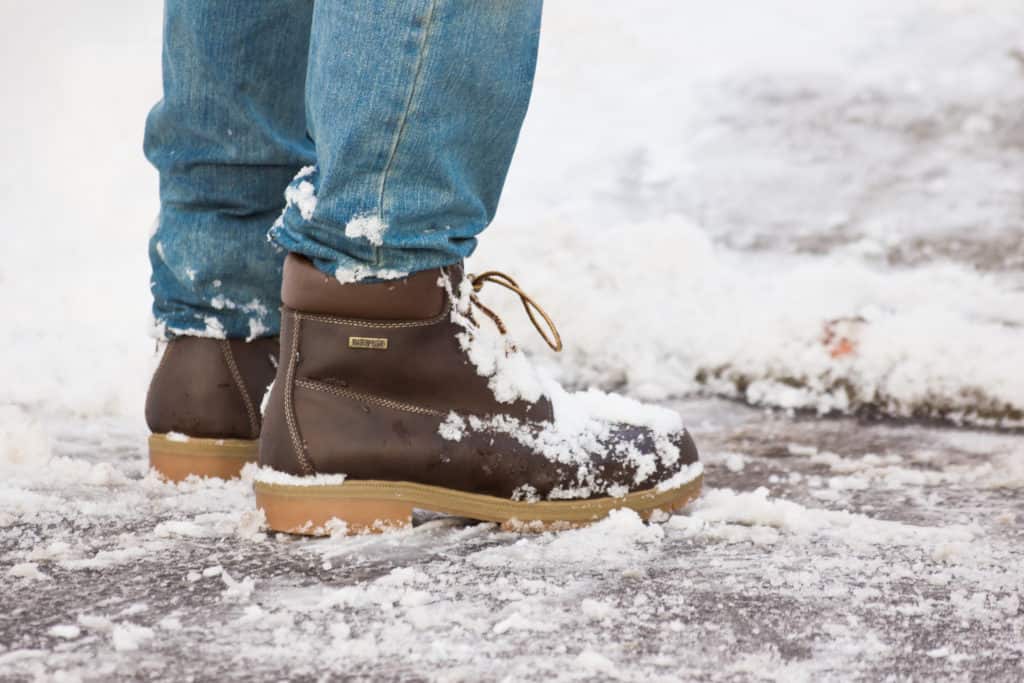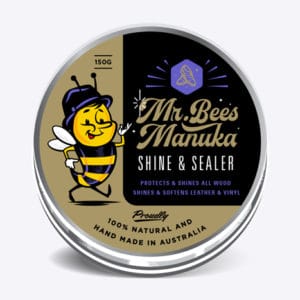Beeswax has been used for thousands of years since the Egyptian times, and is used today in so many industries including skincare, natural polishes, candles and even in the food industry.
The great thing about Beeswax is it’s great waterproofing ability it has. Within this article we are going to discuss the benefits of waterproofing has on your leather, wood, fabric, chopping boards and much more.
You will then see how using beeswax will benefit you in so many ways with all of the uses it has.
- 1. Beeswax Waterproofs Leather
- 2. Beeswax Waterproofs Wood
- 3. Beeswax Waterproof Shoes
- 4. Beeswax Waterproofing Boots
- 5. Beeswax Waterproofing Fabric
- 6. Beeswax Waterproofing Canvas
- 7. Beeswax Waterproofing Terracotta Pots
- 8. Beeswax Waterproofing Grout
- 9. Beeswax Waterproofing Slate Floors
- 10. Beeswax Waterproof Chopping Boards
- 11. Beeswax Waterproof Drizabone
- 12. Beeswax Waterproofing Saddlery
- 13. Beeswax Waterproofing Car Interiors
- 14. Beeswax Waterproofing Vinyl
1. Beeswax Waterproofs Leather
Beeswax waterproofs leather by sealing the outer layer. Beeswax is durable and long-lasting and one of the oldest conditioning treatments out there today.
Beeswax cleans the leather, puts moisture back into the leather, and adds a protective film over the top to the surface of the leather.
This layer of beeswax prevents water stains and locks the moisture in the leather, also protecting your household items and accessories from rain and water.
Here are five examples of leather accessories that beeswax works with that I am sure you have in your home:
1. Leather Couch:
Leather couches receive a lot of wear and tear from sitting, and even more if you have kids or pets. When you apply beeswax onto a leather couch it will protect it from any spills as the beeswax waterproofs that area, and the any water, coffee or drink stains will repel off the beeswax, leaving your leather couch clean.
2. Leather Jackets:
Leather jackets are a leather accessory that you wear when you are outdoors. Applying beeswax to a leather jacket protects the leather from rain or snow. The beeswax seals and waterproofs the leather so the rain or water will run off the beeswax keeping your jacket protected.
3. Leather boots:
Leather Boots being on your feet come in contact with water (puddles), dirt and grime, rain and snow. Applying beeswax over the boot will protect, seal and waterproof while your are outdoors. It is important to have beeswax on your boots to keep your feet dry especially in those colder months.
4. Leather car seats:
There are two main reasons why beeswax is good for water proofing leather car seats. It is good for spills of water or drinks as the liquid will repel off the beeswax and stop the leather from staining, and also any rain that comes through a open window. Leather that doesn’t have beeswax will stain with any liquid and this includes water.
5. Leather bag:
Leather bags are an accessory that is worn indoors and outdoors. While outdoors it is advisable to use beeswax as leather stains if it gets wet with water. The rain or snow can damage the leather so applying beeswax first will then repel the water away from the leather, so your bag would then be stain free.
How To Clean Any Of The Above Leather Accessories With Beeswax:
1. Use a Leather brush or clean cloth to wipe away any dirt or grime from the leather.
2. Apply a thin coat of beeswax using a separate cloth
3. Leave on for 5 minutes
4. Use another separate cloth wipe away any excess.
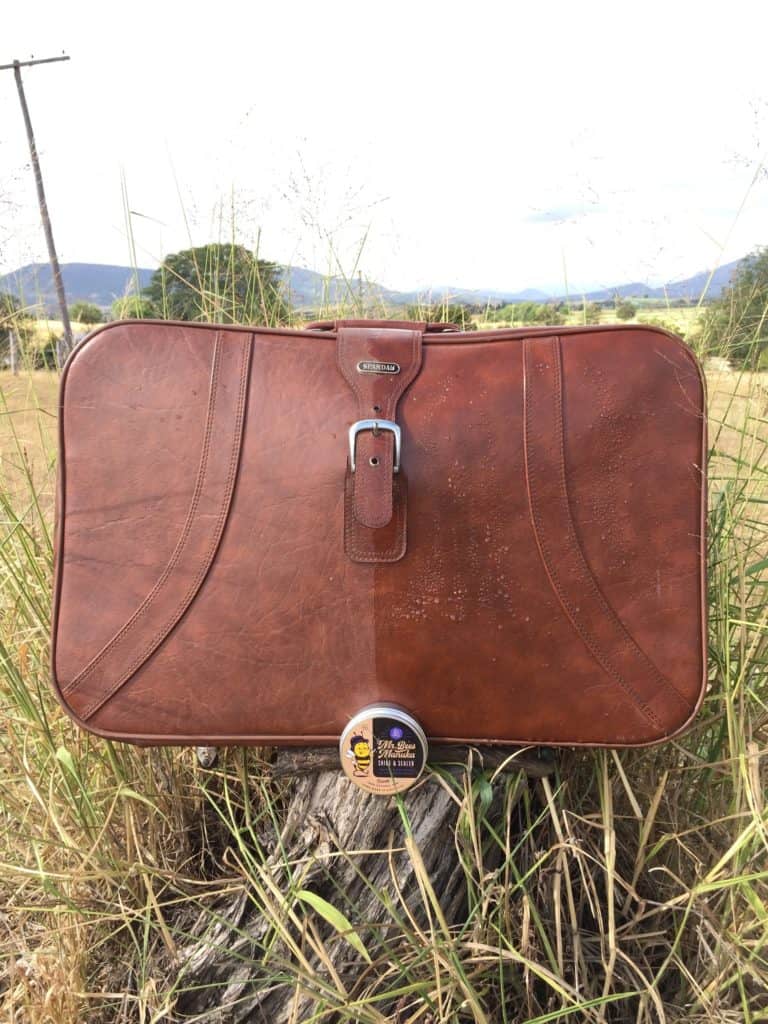
-
Shine & Sealer 150gm$37.00
2. Beeswax Waterproofs Wood
Beeswax waterproofs the outer layer of any wood surface. It seals and locks in the moisture of the wood and protecting it long term against any elements that include rain.
Below are 5 examples of how beeswax works with your wooden furniture or accessory:
Wood Furniture:
Wooden furniture can include inside coffee tables to wooden benches inside your kitchen to outdoor wooden table. Beeswax seals any wood surface locking the moisture within the wood. Beeswax is very good for any outdoor table or furniture piece as the wax prevents mold or mildew occuring protecting the wood in the rain.
When you apply beeswax to any bench or coffee table it is also going to protect that area from any coffee/tea cup circles from marking the bench. The beeswax puts that protective layer between the coffee cup and the wood.
Wood deck:
Wooden deckings are normally out in the elements which means rain and water will hit the wood on those rainy days. This over time may cause mold, mildew and worse case scenario the wood can expand in the rain causing the wood to crack and split. Applying beeswax to your decking will put that extra layer onto the beeswax, protecting the wood from the water damage.
Wooden Chopping Boards:
Wooden chopping boards are used for chopping up vegetables/fruit, cheese and meats. Beeswax is natural and can be used to seal and water proofing the chopping board. The wax prevents staining from any foods going into the wood making it easy to wash away with detergent and water. It also stops meat juices getting trapped within the wood (leaving bacteria trapped within the wood).
(Make sure the beeswax polish you use has completely natural ingredients and that the beeswax is organic)
Wood floors:
Wooden floor boards are the surface where feet and shoes walk over constantly everyday causing wear and tear. Beeswax is good to be applied on floor boards as it seals and protects the wood against spills , water and dirt.
Outdoor wooden furniture:
Outdoor wooden furniture normally consists of wooden benches, tables and chairs. These wooden items are left outside and need protection, as if left without any protection, the wood can expand and slit, mold and mildew can appear on the wood (from the rain). This is why applying beeswax is crucial to protecting any outdoor furniture.
How to clean wooden furniture or boards with Beeswax:
1. Use a Wooden Brush or clean cloth to wipe or brush away any dirt from the wood.
2. Apply a layer of Beeswax to the wood rubbing until it until it is covered with a sponge or a cloth.
3. Use another clean cloth to wipe of any excess to give the wood a dry finish.

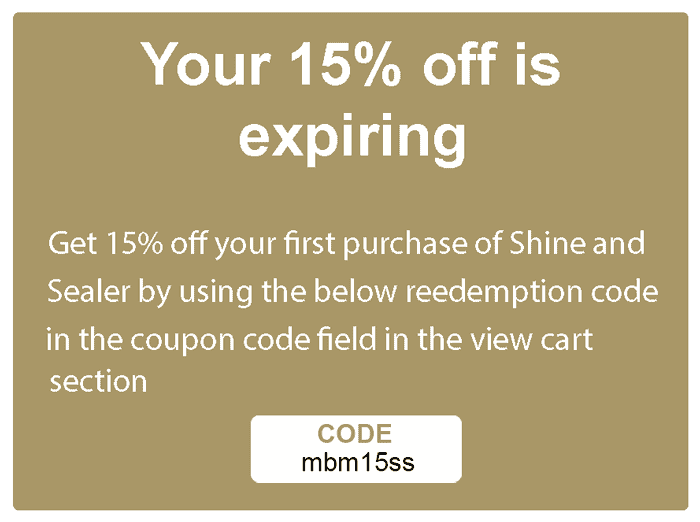
3. Beeswax Waterproof Shoes
Leather shoes is something most people wear daily. It is important to keep your shoes clean and free from water staining the leather. Beeswax on your leather will give your shoes a beautiful shine, and will ensure water will bead off the leather.
Below are the different types of shoes you can use Beeswax on:
Leather Loafers: Beeswax polish is great on any colour leather loafers. It can also be applied to waterproof any wooden or rubber soles or heels of the loafer. Just avoid suede as a material.
Leather Dress Shoes: Beeswax polish is great on any dress shoes including any leather laces. Beeswax can be used on any colour and also waterproofs rubber or wooden soles or heals of the dress shoe.
Leather Shoes: Beeswax polish is great for any colour shoe, the beeswax waterproofs the leather. Beeswax also can be used on the heel if it is wood or rubber to waterproof those areas also. Do not use any beeswax on suede areas.
Suede Shoes: Avoid using Beeswax on any Suede shoes. Beeswax does not work well on anything furry.
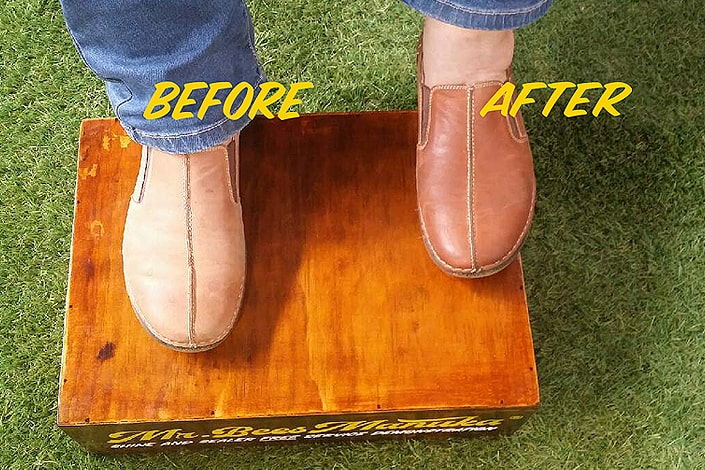
4. Beeswax Waterproofing Boots
Boots are used for so many purposes including for work boots, hiking and casual wear. They are a choice for the colder weather as they keep your feet warm. Beeswax usage on boots is crucial as the wax waterproofs the outside of the leather keeping your feet dry (and toasty).
Below are different types of Boots you can use Beeswax on:
Hiking Leather Boots: Beeswax is great on any coloured hiking boots. The beeswax can be applied to the leather and also on leather laces, rubber soles or wooden heels.
Work Leather Boots: Beeswax is great on any coloured leather work boots. The wax is suitable for leather laces, rubber or wooden soles. The Beeswax will water proof the leather, wood or rubber within the boot.
Nubuck Leather Boots: Beeswax is not suitable for Nubuck leather as it is a very short fur. You will need a suede cleaner.
Chukka Boots: Chukka boots are either in leather or in suede. Beeswax is only suitable for leather and not suede.
-
Shine & Sealer 150gm$37.00
5. Beeswax Waterproofing Fabric
Beeswax can be used to waterproof fabrics including carcovers to camping tents to even beeswax wraps.
Here are 3 different uses you can use Fabric for to Waterproof:
Carcovers: Car covers are normally made from polyester or cotton fabrics. Beeswax can be applied to the fabric to waterproof the material to keep your car dry.
Camping Tents: Camping tents are normally made from polyester fabrics. Beeswax can be applied to the material to further waterproof the material against rain.
Beeswax Wraps: Beeswax is used to make beeswax wraps. The wax is melted onto organic coton fabric. The wax then wraps food, but also in the washing process repels water for cleaning. (only use organic beeswax ).

6. Beeswax Waterproofing Canvas
Canvas is used for many products including bags, boat covers, and shoes. It is normally made from cotton or polyester, beeswax makes these items waterproof. You apply the beeswax directly onto the canvas which will attach to the fabric protecting it from water.
Below are three examples of Beeswax Waterproofing Canvas items:
Boat Covers: Canvas covers on boats are subject to salt water and need protection. Overtime saltwater can break apart the canvas (wrecking the material) so Beeswax is perfect addition to do this. The beeswax makes the canvas stronger.
Canvas Bags & Shoes: Canvas Bags and Shoes are both worn outside and as they are fabric based, they both need waterproofing. The beeswax will protect the canvas from dirt, and water.

7. Beeswax Waterproofing Terracotta Pots
Terracotta is an art clay used to make pottery and sculptures; it’s also used as roofing tiles. The traditional design of terra cotta pots provides a rustic look for your garden or porch. Beeswaxing it waterproofs the terracotta, repels water, and creates an invisible seal on its surface.
Here are three ways beeswax waterproofs terracotta pots:
Terracotta pots (inside of the pot): Apply a thin coat of beeswax to the inside walls of the terracotta pot using a soft rag or brush. Let the wax settle for a few hours before buffing off any excess. This process waterproofs your terracotta pot, helps prevent water from seeping through the walls and ruining the potting soil inside.
Terracotta pots (outside of pot): Apply a thin coat of beeswax to the outside walls of the terracotta pot using a soft rag or brush. Let the wax sit for a few hours before buffing off any excess. This process waterproofs your terracotta pot, creates a protective seal that repels water, and gives it a beautiful sheen.
Terracotta pots (potting soil): Beeswax traps moisture by creating a waterproof barrier on the inside, outside, and bottom of the terracotta pot. This method is perfect for potted plants that need extra moisture in dry or desert climates because it helps prevent water from evaporating out of the soil.
-
Shine & Sealer 150gm$37.00
8. Beeswax Waterproofing Grout
Beeswaxing grout waterproofs it by creating a barrier around the grout that repels the water. You’ll notice that waxing your grout lines prevents mold and mildew from forming in those spaces, which are common problem areas that are difficult to clean. Here’s how beeswax waterproofs waxed grout:
Apply a thin coat of beeswax to the waxed grout using a soft rag or brush. Let this settle for an hour before buffing off any excess. This method waterproofs your grout, creates a barrier that repels water, and prevents mold and mildew from forming in your grout lines.

9. Beeswax Waterproofing Slate Floors
Waterproofing your slate floor is an important part of maintaining its durability and appearance; beeswax does the job by creating a barrier around the grout that repels water. You’ll notice that waxing your grout lines prevents mold and mildew from forming in those spaces, which are common problem areas that are difficult to clean. The beeswax prevents the grout from ever becoming unsealed and losing its waterproofing effect.
Here’s how to beeswax waterproofs slate floors:
Use a soft rag or brush to apply a thin coat of beeswax to the unsealed, unsealed slate floor using a circular motion. Let this settle for an hour before buffing off any excess. This method waterproofs your slate floor, creates a barrier that repels water, and prevents mold and mildew from forming in the grout lines. In addition, it preserves the colour of the sealant and prevents staining or other discoloration that may occur with other methods.
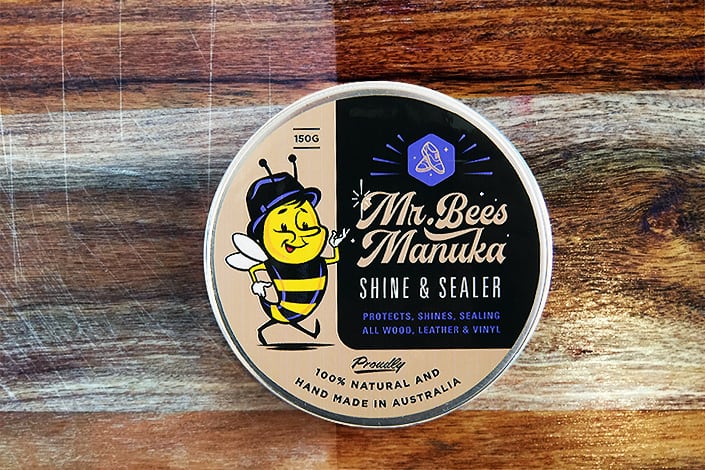
10. Beeswax Waterproof Chopping Boards
Beeswaxing your chopping board waterproofs it by creating a barrier around the wood that repels water. You’ll notice that waxing your chopping board prevents bacteria from forming of those spaces, which are common problem areas that are difficult to clean. The beeswax prevents the wood from ever becoming unsealed and losing its waterproofing effect.
Here’s how beeswax waterproofs chopping boards:
Apply a thin coat of beeswax to the wood using a soft rag or sponge. Let this settle for an hour before buffing off any excess. This method waterproofs your chopping board, creates a barrier that repels water, and prevents bacteria from forming on the surface. It also preserves the colour of the board and prevents staining or other discoloration that may occur with other methods.
-
Shine & Sealer 150gm$37.00
11. Beeswax Waterproof Drizabone
Waterproofing your Drizabone jacket or hat with beeswax is an important part of protecting the life of the garment. It also provides a clean look to your wear by defending against water, oil, and salt stains. Drizabone hats and jackets are made from oilskin fabric, which means that they can lose their waterproofing effect over time. You’ll notice that waxing your Drizabone jacket or hat makes it water-resistant, even in heavy rainstorms.
Here’s how beeswax waterproofs Drizabone jackets and hats:
Wash the garment with warm soapy water to remove oil and dirt, then dry it thoroughly. Apply a thin coat of beeswax using a soft rag or brush on the outside of the fabric. Let this settle for an hour before buffing off any excess. This method waterproofs your Drizabone jacket or hat, creates a barrier that repels water, and prevents mold and mildew from forming on the surface.

12. Beeswax Waterproofing Saddlery
Keeping your saddlery out in the elements like the horse’s saddle, the stirrups, and the reins can cause it to lose its waterproofing effect. Keeping those elements away from the water prevents mold and mildew from forming on your saddle. In addition to that, beeswax waterproofs saddlery by creating a barrier that repels water as well preserves color and prevents staining or other discoloration.
Here’s how beeswax waterproofs saddlery:
Apply wax to your saddle using a soft rag or brush. Let this settle for an hour before buffing off any excess that may have formed over time. This method waterproofs your saddlery, creates a barrier that repels water, and gets rid of mold and mildew on the surface. It also preserves colour within the leather and prevents staining or other discoloration.
-
Shine & Sealer 150gm$37.00
13. Beeswax Waterproofing Car Interiors
Beeswaxing your car’s leather seats, steering wheel and upholstery is an important step in protecting the life of your vehicle. It also provides a clean look to your interior by defending against water, oil, and other stains. All of these elements can damage leather furniture and interior fabric if drinks/food or water is spilt over the leather.
14. Beeswax Waterproofing Vinyl
Yes, Beeswax waterproof vinyl. Here are some ways that beeswax waterproofs vinyl upholstery:
1. Vinyl Dashboard in a Car
Waterproofing the vinyl dashboard in your car with beeswax is an important step in protecting the life of your vehicle’s interior. It also provides a clean look to your wear by defending against water, oil, and other stains.
All of these elements can damage leather furniture and interior fabric if exposed to water for too long. After clean washing the dashboard with warm soapy water and tipping it to dry, apply a thin coat of beeswax using a soft rag or brush on the vinyl. Let this settle for an hour before buffing off any excess.
2. Vinyl Floors
Waterproofing your vinyl floors with beeswax and applying a new coat of wax every three months is important in keeping the vinyl clean and preventing mold and mildew from forming on the surface. This also preserves color and prevents staining or other discoloration that may occur over time.

